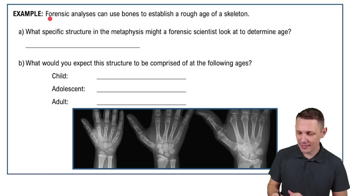Long bones grow in length from the:
a. Diaphyseal line
b. Epiphyseal line
c. Epiphyseal plate
d. Medullary cavity
 Verified step by step guidance
Verified step by step guidance Verified video answer for a similar problem:
Verified video answer for a similar problem:



 6:19m
6:19mMaster Overview of Long Bones with a bite sized video explanation from Bruce Bryan
Start learning